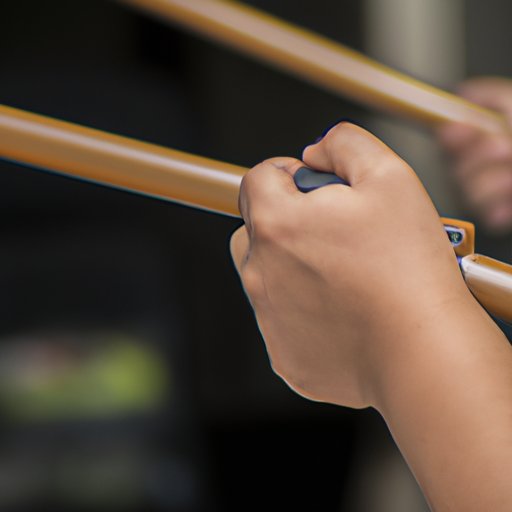
I. Introduction
Knowing how to hold a gun properly is a crucial skill for anyone who wants to shoot accurately and safely. Whether you’re a beginner or an experienced shooter, a proper grip is essential for control and precision. In this article, we’ll provide tips and techniques for holding a gun, starting with the basics and moving on to advanced techniques.
II. The Basic Grip of Holding a Gun: Tips and Techniques
Having a correct grip on your firearm is one of the most important factors when it comes to safety, accuracy, and control. A proper grip allows you to absorb recoil and reduces the chances of a malfunction. Here’s what you should focus on:
- Stance: Stand with your feet shoulder-width apart, one foot slightly forward for balance.
- Hand placement: Your non-dominant hand should support the gun from below with the webbing of your thumb resting on the underside of the trigger guard. Your dominant hand should grip the handle firmly with the webbing of your thumb pressed high on the backstrap of the grip.
- Finger placement: The trigger finger should stay outside the trigger guard and rests along the side of the gun’s frame above the trigger.
- Grip pressure: Hold the gun firmly with both hands. The grip should be firm enough to control the recoil, but not so tight that it interferes with your accuracy.
Don’t worry if you’re having trouble visualizing the grip techniques; it’s perfectly normal when getting started. You can seek the help of experts to guide you through the process.
III. Holding a Gun for Beginners: The Dos and Don’ts
If you’re a beginner, it’s essential to learn the proper grip to avoid dangerous accidents. Here are some tips:
- Body positioning: Stand with your feet shoulder-width apart, pointed straight ahead, with your hips and shoulders squared toward the target.
- Finger position: Keep your finger off the trigger until you’re ready to shoot.
- Hand placement: Use both hands. The non-dominant hand is responsible for holding the gun steady, and the dominant hand is responsible for pulling the trigger.
- Grip pressure: Don’t grip the gun too tightly; it can cause jerking and unwanted movement when you pull the trigger.
Remember that handling a firearm can lead to deadly consequences. Ignoring these basic rules could lead to accidents, and improper use of a gun can result in legal prosecution. Safety around firearms is non-negotiable, so follow these pieces of advice to the letter.
IV. Expert Tips for Holding a Gun with Accuracy and Safety
If you’re an advanced shooter, your grip technique and control will ultimately determine your success, whether it’s for competitive shooting, hunting, or self-defense. Here are some advanced techniques to help:
- Proper grip pressure: Adjust your grip pressure depending on the type and caliber of your firearm. A lighter grip is suitable for pistols, while a more robust grip pressure is suitable for heavy-caliber rifles.
- Customized grip: Get a customized grip to fit the size and shape of your hand. A gun that feels large or small will affect your shooting comfort, accuracy, and overall performance.
- Finger placement: Experiment with where you place your trigger finger on the trigger to achieve the best results. A firmer touch of your support hand forces your trigger hand to apply less force.
Don’t worry if these techniques take some time getting used to – it’s worth it for the improvement in your weapon control and accuracy.
V. Mastering the Grip: Advanced Techniques for Holding a Gun
Advanced techniques are essential for optimizing muscle memory for perfect grip control. Here are some techniques to help:
- Dry firing: Dry firing (practicing shooting without live ammunition) is an outstanding way to practice grip control and improve your technique without leaving your home or range.
- Dummy rounds: Using dummy bullets further reinforces the muscle memory used for proper grip control
- Repetitions: Practice often and keep repeating the skills to reinforce your muscle memory and to master your grip control.
These techniques may be advanced, but they’re necessary for perfecting your grip control and increasing your accuracy.
VI. Common Mistakes to Avoid While Holding a Gun: A Step-by-Step Guide
Even the best of us can make mistakes when handling firearms. Here’s a step-by-step guide on how to avoid common grip mistakes:
- Cross-handed grip: Make sure the hand that pulls the trigger also grips the firearm’s handle. A cross-handed grip affects the position of your arms, which reduces accuracy, and causes your arms to tire more quickly.
- Breaking the wrist: Keep your wrist straight when firing; bending it downwards or upwards can cause the gun to recoil in unpredictable ways.
- Finger placement: Make sure that your finger is outside the trigger guard until you’re ready to fire and avoid putting it on the trigger before you’ve pointed your firearm at your target.
By practicing the proper grip techniques, you’ll avoid the common grip mistakes that can affect your control accuracy and safety.
VII. Conclusion
Mastering the proper grip for holding a gun is crucial for improving your safety, accuracy, and control. Whether you’re a beginner or an expert, the fundamentals remain the same – proper stance, hand placement, finger placement, and grip pressure are vital for grip control and accuracy. Remember to keep practicing, be mindful of safety rules, and seek additional guidance from experts if necessary. By doing so, you’ll increase your grip control, safety, accuracy, and enjoyment of shooting sports.





